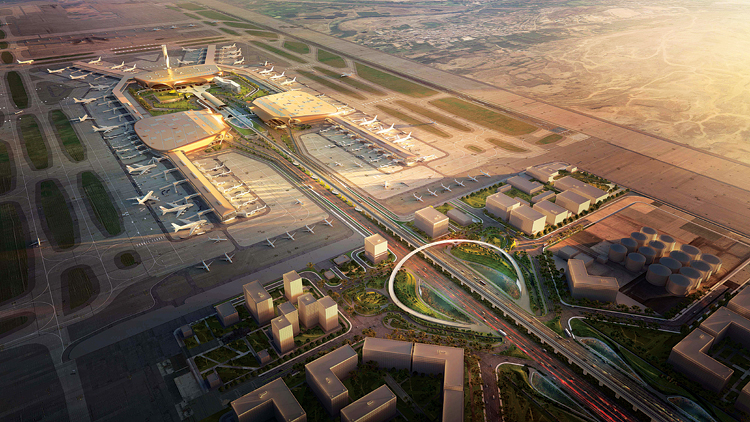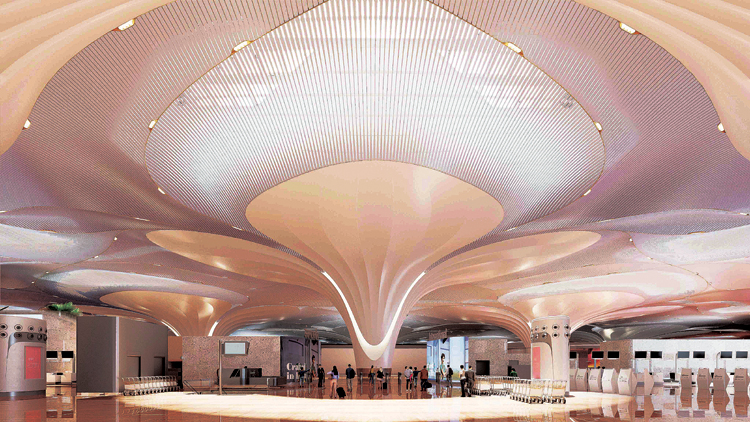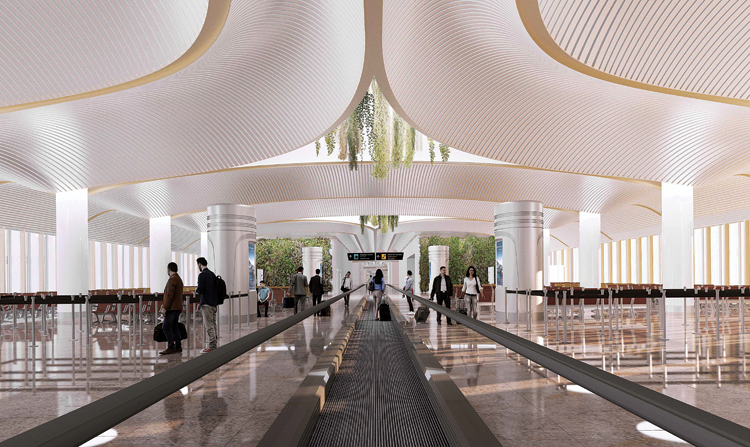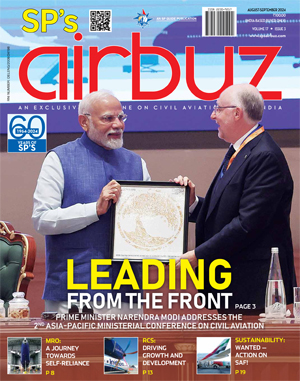Charting a Greener Future
Navi Mumbai International Airport is redefining aviation excellence by pioneering sustainability, innovation, connectivity and economic growth

Have you ever visited a greenfield airport under construction right in your backward? Well, I have, and trust me the experience is mind-boggling. Boasting of being India’s very first airport with sustainable aviation fuel fueling and refueling capability, the Navi Mumbai International Airport Limited (NMIAL) project worth eighteen thousand crores is anticipated to be a game-changer for trafficheckled passengers of Mumbai and Navi Mumbai.
The airport spread over 1,160 hectares of land and located approximately 35 km from Mumbai Airport will have four passenger terminals, one dedicated general aviation terminal, one cargo terminal, two parallel runways – 3,700m long and 60m wide and spaced 1.55 km apart and at least 42 aircraft parking areas in the first two stages and 245 aircraft stands in the remaining three stages. The airport is expected to create over four lakh job opportunities.
SUSTAINABILITY & NMIAL
The airport management is currently in talks with various SAF manufacturing companies based in India like Praj Industries, IOC, BPCL and many more, but a final deal is yet to be signed. India is currently facing the challenge of garnering adequate feedstock for SAF production. Due to less produce, naturally the SAF rates are much higher than normal ATF making life more difficult for operators.

However, experts are of the opinion that India has abundant feedstock as compared to west and very soon India will emerge as the one of the biggest producers of SAF. Eyeing this forecast, the airport management has allotted considerable space for SAF storage.
Boasting of being India’s very first airport with sustainable aviation fuel fuelling and refuelling capability, the Navi Mumbai International Airport Limited (NMIAL) project worth eighteen thousand crores is anticipated to be a gamechanger
Speaking of sustainability, the NMIA has kept the natural water reservoirs like ponds and lakes in the airport vicinity intact to source water for construction and later for human consumption.
The complete planning of the airport is done in such a way that it will be highly eco-friendly and energy-efficient. The operations of the airport will depend on the on-site solar power generation. Another interesting fact is that only electric vehicles will be permitted inside the vicinity of the airport and solar-panelled rooftops for all terminals, keeping sustainability at the core of its operations.
Besides right at the construction phase, there are huge storage tanks for rainwater harvesting along with recycling wastewater and organic waste.
THE STRUCTURE & OPERATIONS
The airport construction was approved in 2017 but the actual construction work commenced in 2021 after Adani Group took over from GVK Group. Since 2018, the work was hit by various hurdles like litigations and land acquisition delays. The northern part of the planned site was full of swampy marine soil, which had to be raised to prevent flooding. Additionally, another significant obstacle during airport construction was a tall hill containing millions of cubic meters of rock.
But leaving all of it behind, currently work is in progress with almost 60 per cent of terminal I work under completion targeting official opening by March 2025. Phase I of the airport consisting of terminal I, one 3,700-metre-long runway strip and will have an annual capacity of handling around 20 million passengers and 0.3 metric tonne of cargo, thus considerable reducing the pax load from Mumbai International airport, one of the busiest airports in the world. Construction of the terminal, ATC tower and ancillary buildings is underway at a rapid pace.

As the construction of other terminals at the airport will progress over the course of next few years the passenger capacity will be augmented by 90 million passengers per annum once the final phase is completed. The NMIA will be constructed in five phases. The second runway, four terminals along with an increased passenger capacity of nine crore will be created in Phase 3, 4 and 5. The terminals will be interconnected on the airside and landside with 10 kms long APM offering full flexibility to passengers. Besides passenger terminals are designed in such a way to keep convenient walking distance from check-in to boarding gates.
One of the most interesting aspects of the terminal building is that its design is inspired from India’s national flower – The lotus and the building structure and design will resemble a blooming lotus depicting a unique fusion of traditional Indian heritage and futuristic elegance and technology. Interestingly all four terminal buildings will have the same lotus petal design thus giving a beautiful visual impact from an aerial view.
The airport spread over 1,160 hectares of land and located approximately 35 km from Mumbai Airport will have four passenger terminals, one dedicated general aviation terminal and one cargo terminal
Another one of NMIAL’s unique feature is that it has India’s largest planned General Aviation facility in the country with a capacity to hold over 67 General Aviation aircraft and more along with heliport operations.
On the Maintenance, Repair, Overhaul (MRO) front, nothing is fixed as of now, but the airport management is open to talks with the airlines as well as the third-party MROs to open their hangars and MRO shops in the airport area. As the talks progress, the airport management is expected to reach a concrete plan by September-October 2024.
Fuel facilities inside the terminal are currently being developed by the airport operator. Indian Oil Corporation will lay a common-use underground fuel pipeline from Jawaharlal Nehru Port Trust to the airport. Contracts for baggage handling, x-ray machines, aircraft rescue and fire fighting vehicles are finalised as the airport prepares for launch in 2025. The airport area will offer parking for up to 5,500 vehicles.
AIRPORT CONNECTIVITY
The exact location of this airport is on National Highway 4B, close to Panvel. NMIAL will be connected via multimodal connectivity through metro, road, rail, and waterways making it India’s first airport with multimodal connectivity altering the complete transport paradigm of Mumbai and suburbs.
The Navi Mumbai Airport Influence Notified Area (NAINA) covers an area of 371 sq. km including 174 villages within a 25-km radius of Navi Mumbai International Airport.

The airport will be connected to the road in three directions: NH 4B (348), the Sion-Panvel Highway and through Atal Setu (new sea link). The airport will be connected to the railway network by Targhar Railway station. Metro connectivity to the airport will be via Metro line 2D: DN Nagar to Mandale – Mankhurd, metro line 8: Mumbai Airport to Navi Mumbai Airport and Navi Mumbai Pendhar Belapur Taloja metro line. In the future, there’s a plan to connect the airport through hovercraft from Colaba and through cargo from Raigad in Phase 2.
The airport will be the first in the country with automated passenger movement within its 1,600 hectares for 10 kms on the city side and on the airside.
NMIAL will be connected via multimodal connectivity through metro, road, rail, and waterways making it India’s first airport with multimodal connectivity altering the complete transport paradigm of Mumbai and suburbs
Further City and Industrial Development Corporation (CIDCO) has proposed two new metro routes to boost connectivity within the Navi Mumbai Airport Influence Notified Area (NAINA) region. The first route is planned from the Ulwe coastal road to Ambivali in Raigad, focusing on accelerating connectivity from NAINA areas to NMIAL. The second proposed route under consideration is the Kalamboli-Chikhale-Kon corridor. This route will also improve accessibility to key locations like Taloja MIDC, Panvel, and neighbouring areas.
Thus, armed with best-in-class infrastructure and smooth connectivity from the airport to other parts of the city will encourage MNCs and early-stage startups to set up their offices in and around Panvel and adjoining areas thus carving Panvel and adjoining areas are commercial hotspots in the region.
TOURISM PARK
In an attempt to develop an entire aerocity eco-system around NMIAL, the government is keen to develop a tourism zone on 1,000 acres of land around the airport. This zone will have amusement parks, hotels, restaurants, hotel management and training institutes, and ancillary activities. The tourism zone is one of the provisions in the recent draft tourism policy for Maharashtra, expected to be tabled before the state cabinet.
As the Navi Mumbai International Airport gets operational which should most likely be towards the end of this year or Q1 of 2025, Mumbai will become the first city in the country to hold two international airports.
As the construction and growth of NMIAL is fast approaching the expected launch date, the complete surrounding area is expected to undergo a sea of change with economic development, creating fresh employment prospects and attracting investments not just in and around Mumbai and Suburbs but surrounding cities like Pune and Goa.
Sustainability is the new buzz word in aviation and every stakeholder, be it an airline, airport, OEM, MRO, ground handlers are vying for different means to adopt sustainable practices and meet their targets of carbon neutrality. Navi Mumbai airport however is set to make its mark in not only achieving its sustainable targets but being one of the top-ranking sustainable airports in the world.





